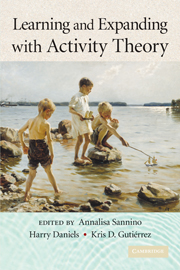Book contents
- Frontmatter
- Contents
- Contributors
- Editors' introduction
- 1 Activity Theory Between Historical Engagement and Future-Making Practice
- PART ONE UNITS OF ANALYSIS
- PART TWO MEDIATION AND DISCOURSE
- 5 Mediation as a Means of Collective Activity
- 6 Digital Technology and Mediation: A Challenge to Activity Theory
- 7 Contextualizing Social Dilemmas in Institutional Practices: Negotiating Objects of Activity in Labor Market Organizations
- PART THREE EXPANSIVE LEARNING AND DEVELOPMENT
- PART FOUR SUBJECTIVITY, AGENCY, AND COMMUNITY
- PART FIVE INTERVENTIONS
- Bibliography
- Author Index
- Subject Index
5 - Mediation as a Means of Collective Activity
Published online by Cambridge University Press: 05 June 2012
- Frontmatter
- Contents
- Contributors
- Editors' introduction
- 1 Activity Theory Between Historical Engagement and Future-Making Practice
- PART ONE UNITS OF ANALYSIS
- PART TWO MEDIATION AND DISCOURSE
- 5 Mediation as a Means of Collective Activity
- 6 Digital Technology and Mediation: A Challenge to Activity Theory
- 7 Contextualizing Social Dilemmas in Institutional Practices: Negotiating Objects of Activity in Labor Market Organizations
- PART THREE EXPANSIVE LEARNING AND DEVELOPMENT
- PART FOUR SUBJECTIVITY, AGENCY, AND COMMUNITY
- PART FIVE INTERVENTIONS
- Bibliography
- Author Index
- Subject Index
Summary
Yrjö Engeström has elaborated a very interesting and fruitful variant of cultural-historical activity theory, which he and his collaborators successfully use in analyzing and solving concrete problems in developmental work research. The activity approach and activity theory in different forms have been very popular among Russian psychologists and philosophers for many decades. Although in Russia a lot of research in different human sciences has been carried out in the framework of cultural-historical activity theory, many of its key ideas continue to be insufficiently elaborated, it is given different interpretations, and there are discussions about the meaning of its basic tenets.
In recent times some scholars in Russia and other countries have begun to criticize the activity approach and its results. I think that the results of Engeström's research are important in the context of contemporary discussions about the possibilities of activity theory. In this chapter, I will try to analyze the place of Engeström's variant of activity theory among other variants. In this connection, I will try to elucidate some key notions of the activity approach, first of all those of mediation and subject. Specifically, I will analyze reflective mediation as a means of changing collective activity.
ACTIVITY
It is important to stress that the idea of activity was first introduced in philosophy and subsequently in the human sciences as a means of overcoming the Cartesian opposition between the subject and the object, between the “inner” world of consciousness and the “outer” world.
- Type
- Chapter
- Information
- Learning and Expanding with Activity Theory , pp. 75 - 87Publisher: Cambridge University PressPrint publication year: 2009
- 24
- Cited by



